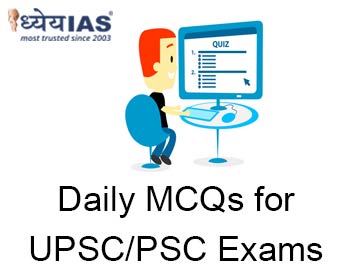Home > Daily-mcqs
Daily-mcqs 10 Feb 2025

Q1:
According to the "Panchamrit" goals announced by India at COP26, which of the following is a correct statement about India's climate change commitments?
A: Achieve net-zero emissions by 2070, increase non-fossil fuel capacity to 500 GW by 2030, and aim to meet 50% of energy needs from renewable sources by 2030.
B: Reduce carbon emissions by 1 billion tonnes by 2025, reach 100% renewable energy by 2030, and achieve net-zero by 2050.
C: Decrease carbon intensity by 25% by 2030, install 200 GW of solar power by 2030, and reduce fossil fuel dependence by 50%.
D: None of the above.
Answer: A
Explanation:
"Panchamrit" refers to the five-point climate change strategy announced by India at COP26, including:
1. Achieving net-zero emissions by 2070.
2. Increasing non-fossil fuel energy capacity to 500 GW by 2030.
3. Aiming to meet 50% of energy needs from renewable sources by 2030.
4. Reducing projected carbon emissions by 1 billion tonnes by 2030.
Q2:
Consider the following statements regarding India’s solar power capacity: 1. India’s installed solar power capacity surpassed 100 GW by January 31, 2025, marking a significant milestone in its renewable energy journey. 2. Rajasthan, Gujarat, Tamil Nadu, Maharashtra, and Madhya Pradesh are leading states contributing to India’s overall solar power capacity. 3. The rooftop solar sector installed 10 GW of new capacity in 2024, reflecting a 53% increase from 2023. 4. India’s solar module manufacturing capacity increased from 2 GW in 2014 to 60 GW in 2024, with plans to reach 100 GW by 2030. How many of the above statements is/are correct?
A: Only one
B: Only two
C: Only three
D: All four
Answer: C
Explanation:
Q3:
Consider the following statements regarding the National Policy for Rare Diseases in India: 1. The policy will provide financial assistance of up to Rs. 50 lakh for the treatment of patients suffering from 63 identified rare diseases. 2. The financial assistance will be directly provided to the patients for their treatment. 3. The policy aims to benefit approximately 7-8 crore people in India who suffer from rare diseases. 4. Rare diseases are typically characterized by chronic, progressive, and life-threatening symptoms, making diagnosis and treatment challenging. How many of the above statements is/are correct?
A: Only one
B: Only two
C: Only three
D: All four
Answer: C
Explanation:
Q4:
Match the following age groups with the corresponding Skill India Programme component: Column A (Age Group) Column B (Skill India Programme) 1. 15 to 59 years a. Pradhan Mantri Kaushal Vikas Yojana 4.0 (PMKVY 4.0) 2. 14 to 35 years b. Pradhan Mantri National Apprenticeship Promotion Scheme (PM-NAPS) 3. 15 to 45 years c. Jan Shikshan Sansthan (JSS) Scheme
A: 1-a, 2-b, 3-c
B: 1-c, 2-b, 3-a
C: 1-b, 2-c,3-a
D: 1-a, 2-c, 3-b
Answer: A
Explanation:
· PMKVY 4.0 aims to upskill and reskill a broad age group from 15 to 59 years, enabling them to engage in both emerging technologies and traditional fields of work.
· PM-NAPS focuses on providing opportunities for 14 to 35-year-olds to gain industry-specific training through apprenticeships, thereby improving their chances for future employment.
· JSS Scheme targets a 15 to 45-year-old demographic, focusing on community-based, low-cost training aimed at economically weaker sections, especially women and youth in rural areas.
Q5:
What is the burden of proof in cases where an arrestee claims non-compliance with Article 22(1)?
A: The burden of proof lies with the arrestee.
B: The burden of proof lies with the Investigating Officer or Agency.
C: The burden of proof lies with the Judicial Magistrate.
D: The burden of proof lies with the Supreme Court.
Answer: B
Explanation:
The burden of proof lies with the Investigating Officer or Agency.